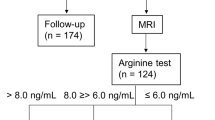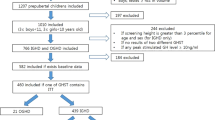Abstract
THE disappearance of iodine-131-labelled human growth hormone (HGH) from plasma has been investigated as part of a study designed to measure the secretion rate of the hormone. This was undertaken because plasma levels alone may not be indicative of the secretion rate of the hormone. Twenty-six adult patients consented to the procedure. Seventeen were diabetics (six required insulin and seven had never been given insulin). Eight were acromegalic (four with diabetes), and five were normal. Thyroidal uptake of radio-iodine was blocked with Lugol's iodine. HGH prepared by the Raben1 technique and purified2 was iodinated by the method of Hunter and Greenwood3. Material of specific activity 30–150 µc./µg was used. It was diluted at once and stored in a diluent containing 0.3 per cent human serum albumin. Each batch was used within 14 days of preparation. The subjects were studied resting, fasting and after 12 h without food or drugs. Care was taken to ensure that where possible each member of the various groups of patients was studied with a different batch of 131I-HGH, and this meant that each batch was used in several types of patients. A weighed dose of 2–5 µc. was given intravenously at about 9 a.m. Blood samples were collected at intervals during the next 2–4 h, cooled, and the plasma radioactivity counted in a well-type scintillation counter to give > 95 per cent accuracy. The plasma proteins were then precipitated with cold 20 per cent trichloroacetic acid (TCA) and the supernatant counted. The protein-bound 131I could then be calculated and was expressed as a percentage of the dose injected and plotted semi-logarithmically against time. In each of the five normals a disappearance curve similar to Fig. 1A was found. Equilibrium was reached in 10 min and a straight-line exponential curve thereafter gave half-times of from 23 to 45 min (see Fig. 2). All seven non-insulin-requiring diabetics gave curves similar to Fig. 1B, reaching equilibrium by 20–60 min and giving final straight-line curves with half-times of from 60 to 185 min (see Fig. 2).
This is a preview of subscription content, access via your institution
Access options
Subscribe to this journal
Receive 51 print issues and online access
$199.00 per year
only $3.90 per issue
Buy this article
- Purchase on Springer Link
- Instant access to full article PDF
Prices may be subject to local taxes which are calculated during checkout
Similar content being viewed by others
References
Raben, M., Rec. Prog. Hormone Res., 15, 71 (1959).
Hunter, W. M., thesis Univ. Lond. (1964).
Hunter, W. M., and Greenwood, F. C., Nature, 194, 495 (1962).
Matthews, C. M. E., Phys. in Med. Biol., 2, 36 (1937).
Laron, Z., and Mannheimer, S., Nature, 207, 298 (1965).
Hadden, D. E., and Prout, T. E., Nature, 202, 1342 (1964).
Author information
Authors and Affiliations
Rights and permissions
About this article
Cite this article
BOUCHER, B. Disappearance of Iodine-131-Iabelled Human Growth Hormone from the Plasma of Diabetic, non-Diabetic and Acromegalic Subjects. Nature 210, 1288–1289 (1966). https://doi.org/10.1038/2101288a0
Issue Date:
DOI: https://doi.org/10.1038/2101288a0
This article is cited by
-
Growth hormone release in unstable diabetes: Tests with saline, arginine, glucagon, and epinephrine
Acta Diabetologica Latina (1973)
Comments
By submitting a comment you agree to abide by our Terms and Community Guidelines. If you find something abusive or that does not comply with our terms or guidelines please flag it as inappropriate.



